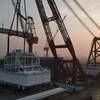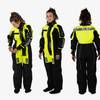Statoil Tender for New Rig Design
Statoil is sending out an invitation to tender for a new type of drilling rig. It is specially-designed by the industry on behalf of Statoil for use on mature fields on the Norwegian continental shelf (NCS).
The purpose is to make drilling and completion of production wells less expensive, more effective and safer, and thereby boost oil recovery.
Discoveries on the NCS are getting smaller and it is becoming more important to increase drilling activity in mature fields to attain the full potential of the NCS. To meet this challenge, lower rig rates, greater drilling efficiency and access to rigs are key factors.
Fit-for-purpose rig
“The rigs delivered to the NCS in recent years were first and foremost constructed for operations in deep water,” says Jon Arnt Jacobsen, chief procurement officer in Statoil.
“That means that they are big and too costly for our requirements and challenges on the NCS. We are therefore taking steps to rejuvenate the rig fleet and ensure that the right rig meets the right requirements.”
The specially-designed category D rig is able to operate at water depths of 100-500 metres and drill wells down to 8,500 metres. It will be a workhorse on mature fields, primarily for drilling production wells and well completion. In this way, Statoil and its partners can get more oil out of the fields.
The rig has been developed in collaboration with various industry players.
Long-term contract
Statoil is issuing a tender for minimum two such rigs for work on the NCS. The contract will run for either eight years with four three-year options or for 20 years firm contract period. This is an unusually long period of contract which will reduce the risk for the drilling contractor who will build the rig. Statoil is also considering taking an ownership stake in the rig.
“Statoil is taking responsibility for a long-term development of the NCS – we see that there are still big opportunities here,” says Jacobsen.
“Now we need to think anew with regard to reducing drilling costs and we will see if it’s possible to achieve a more industrialised development.”
More effective
It is many years since big discoveries were made on the NCS. Minor finds are made but the margins are lower. It is therefore necessary to reduce rig costs in order to realise the potential value. Small finds are also often made near existing fields. Fast developments are then important so that the existing infrastructure can be utilised.
“The key to maintaining today’s production level on the NCS towards 2020 is improved recovery from existing fields and fast and effective development of new fields,” says Øystein Michelsen, executive vice president for Development and Production Norway.
“In order to implement these measures it is crucial that we secure a rig fleet which is adapted to suit the assignments and which can work more effectively.”
A rig like this will be able to drill and do well completions in the North Sea and the throughout the year.
“The goal is that the new rig will drill 20% more effectively than conventional rigs,” says Jon Arnt Jacobsen. “This will help to counteract the cost trends in the rig market.”
Plans call for the contract to be awarded in the third quarter of 2011 and the rigs to be delivered in the second half of 2014. (Source: Statoil)















